
Google Bard vs Chat GPT: The tech duel of the AI assistants
In July 2023, Chat GPT gained a serious competitor in Google Bard - the technology duel for the position of best AI assistant has begun. While both models are based on advanced machine learning techniques to generate human-like texts, they differ in their architecture, training approach and applications. While some praise Google Bard's fast response capability and wide-ranging data, others appreciate the flexibility and nuanced text understanding of the OpenAI language model Chat GPT.
It's time to take a closer look at AI chatbots. We took a look at the skills, advantages, disadvantages and limitations of the two competitors - here is the comparison: Google Bard vs Chat GPT.

All information at a glance Google Bard vs Chat GPT - the duel of the AI chatbots
- Google Bard and Chat GPT: What are AI chatbots?
- Google Bard vs Chat GPT - the hard facts
- Creativity
- Planning
- Summaries
- Fact research
- Google Bard, Chat GPT and DREIKON
- Google Bard vs Chat GPT - the AI at a glance
- Google Bard and Chat GPT - which language model is better?
- The connection between AI and search engines
- The limits of Google Bard and Chat GPT
- Google Bard vs. Chat GPT: Legal consequences
- The relevance of online marketing agencies in the age of Google Bard and Chat GPT
Google Bard and Chat GPT: What are AI chatbots?
Since the rise of the OpenAI chatbot Chat GPT and at the latest with the appearance of "Google Bard", AI chatbots have been on everyone's lips. AI language models are computer programs that can simulate human-like conversations in real time. In the case of Google Bard and Chat GPT, communication with the chatbots is possible without a third-party provider. There are three key factors that LLMs (Large Language Models) have in common:
Modern language models, including Google Bard and Chat GPT, use natural language processing techniques to understand human language and respond appropriately. With this approach, the bots can recognize the context, meaning and intention of the user input.
Instead of being explicitly programmed to perform a specific task, an AI system is trained using data to independently identify patterns and correlations. In contrast to a simple, rule-based bot, an LLM can therefore learn from interactions and improve its responses over time.
The areas of application for Google Bard and Chat GPT are diverse. In contrast to chatbots, which were developed for specific tasks such as customer support, Google Bard and Chat GPT can cover a wide range of topics and conduct more complex conversations.
Google Bard vs Chat GPT - the "hard facts"
Costs
Google Bard is fully available without having to pay for it. In contrast, OpenAI offers two models of the Chat GPT bot: Chat GPT-3.5 is free of charge, while Chat GPT-4 costs 20 euros per month and is limited to 25 messages within three hours. Chat GPT-4 advertises an improvement in the area of language processing capability, which increases accuracy when solving complex tasks.
Languages
It is not possible to say exactly how many languages the chatbots from Google and OpenAI speak, as knowledge of the individual languages varies greatly. However, both Google Bard and Chat GPT speak at least 50 languages.
Registration
A Google account is required to use Google Bard. To use Chat GPT, you must create a user account.
Update: What the new versions of the language models can do
Chat GPT-4 Turbo
On November 6, 2023, OpenAI CEO Sam Altman and Microsoft CEO presented the new Chat GPT update. These functions are new:
- Faster responses: The Turbo version offers a faster response time than previous versions. Advanced knowledge: Chat GPT-4 Turbo has knowledge up to April 2023, providing more up-to-date information than previous models.
- Better understanding and generation of texts: The latest version understands complex conversational queries better and generates more precise, relevant and coherent responses
- Advanced multimodality: Turbo supports the integration of images into the dialog, enabling it to interpret images and answer questions based on them or, conversely, generate images based on text descriptions (using the DALL-E tool).
- Advanced tools and features: Turbo has specialized tools such as browsing uploaded files (file browser), performing web searches (web browser) and executing Python code (Jupyter notebook environment).
Gemini Advanced Ultra 1.0
The update, including the name change, was announced back in December: Google Bard becomes Gemini. The basic model remains free of charge, but the paid version Gemini Advanced Ultra 1.0 comes with extended features:
- Increased performance: Gemini Advanced Ultra 1.0 is significantly faster and more efficient than the basic model and can therefore complete more complex tasks in less time.
- Advanced multi-modality: The successor model can process different types of information, such as text, images and audio, simultaneously.
- Improved programming capability: Gemini Advanced Ultra 1.0 can solve complex programming tasks.
- More context length: The language model can understand longer text passages and more complex contexts, delivering better results in text generation and translation.
- In-depth file analysis: The AI can analyze large amounts of data to identify patterns and trends.
- Use also via app: Gemini can be used via a mobile app on a smartphone or tablet.
This article was written on the basis of Chat GPT-4 and Google Bard, the newer features of Chat GPT-4 Turbo and Gemini Advanced Ultra 1.0 are therefore not yet taken into account.
Google Bard vs Chat GPT - the AI at a glance
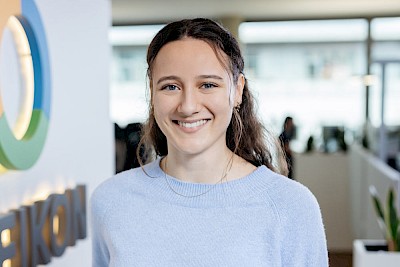
Artificial intelligence meets human expertise
In the era of the digital revolution, artificial intelligence is undoubtedly impressive. However, the nuances of the human mind, creative inspiration and years of experience cannot simply be replaced by an algorithm - rather, the new technical possibilities are a supplement to our skills. Would you like real texts instead of automated answers? Then we look forward to getting to know you in a no-obligation initial consultation.
User-friendliness - Google Bard vs Chat GPT
In purely visual terms, there are already some differences that have a significant impact on user-friendliness. Google Bard provides formatted and therefore clearer answers: headings and paragraphs ensure quick text entry. In contrast, Chat GPT mostly provides the answers in unformatted blocks.
Both Google Bard and Chat GPT offer the option of editing a question after it has been asked. Google Bard generates a new answer and overwrites the previous one. In the OpenAI language model Chat GPT, the individual questions including the respective answers can be clicked on one after the other. The original questions and answers are therefore retained. In addition, both AI generators offer a sidebar in which all questions ever asked or all previous chats are listed.Users have the option to rate the quality of the answers in both chatbots. Clicking on the thumbs up or thumbs down button opens an input field that can be used to request more detailed feedback. Giving reasons for the rating is optional for both Google Bard and Chat GPT.
Answers can be customizedGoogle Bard also scores with a few extras: Don't like reading long texts? Click on the speaker icon in Google Bard to have the answer read out loud. Don't like the first answer generated? Google Bard provides you with further answer suggestions that you can simply click on one after the other. The answers from the AI language model can be shared directly and exported to Docs, for example, or checked manually in the search engine by clicking on the Google logo. In addition, each answer can be customized in terms of conversational style and length: Whether shorter, longer, simpler, more informal or more professional - Google Bard delivers the desired answer.
Chat GPT can also generate responses according to certain parameters, but this requires a small detour via the settings. This allows you to add custom instructions to the language model so that the OpenAI chatbot automatically takes certain preferences into account (e.g. a professional tone versus a casual one) without you having to formulate this in a prompt every time.
Google Bard vs Chat GPT: Google Bard clearly scores in the area of user-friendliness thanks to the wide range of additional options and intuitive operation.
Creativity - Google Bard vs Chat GPT
Human creativity seems to know no bounds. But what about artificial intelligence? If you confront the two text generators with the input "Create a three-stanza poem for Mother's Day", for example, you can see striking differences in the lyrical and creative quality of the texts.
Chat GPT scores in creative text creation with a structured meter, a sophisticated language style, a consistent rhyme structure, a varied and expressive choice of words and stylistic devices such as metaphors and comparisons. Google Bard, on the other hand, delivers a far simpler text in a sometimes sober tone without outstanding poetic qualities.Google Bard vs. Chat GPT: It is clear that the OpenAI chatbot Chat GPT is far more suitable for producing creative texts than Google Bard.
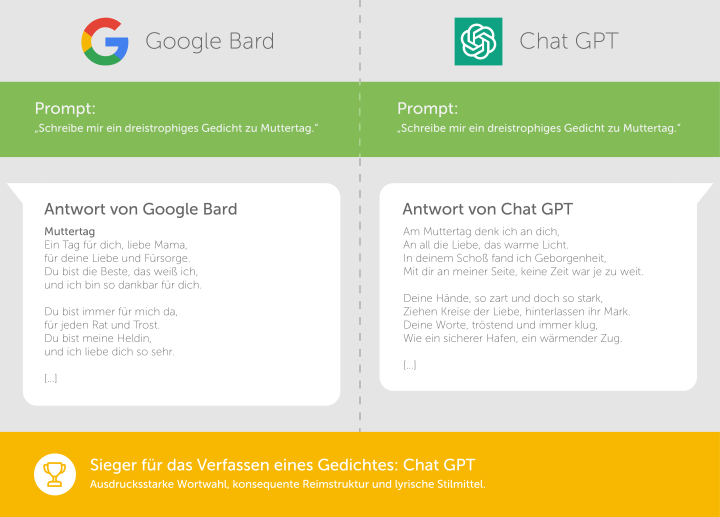
Planning - Google Bard vs Chat GPT
There are many possible uses for AI generators such as Google Bard and Chat GPT. These include planning day trips, vacations, birthdays and much more. We tested which chatbot is best suited to planning a week-long vacation.
Google Bard and Chat GPT provide well-structured plans and a varied vacation program. Google Bard provides some information with pictures. The pictures are very helpful when planning a vacation and make the entire text more vivid. The Google language model also offers additional tips for a vacation in Barcelona. For example, it provides information about other excursion destinations and traditional dishes, as well as pointing out the high level of tourism.The text of the OpenAI language model does not offer any images, but also provides well-structured answers and a recommendation for the Barcelona Card, which grants free entry and discounts to many attractions and activities.
Google Bard vs. Chat GPT: In the "Planning" category, Google Bard impresses with images and helpful additional information.
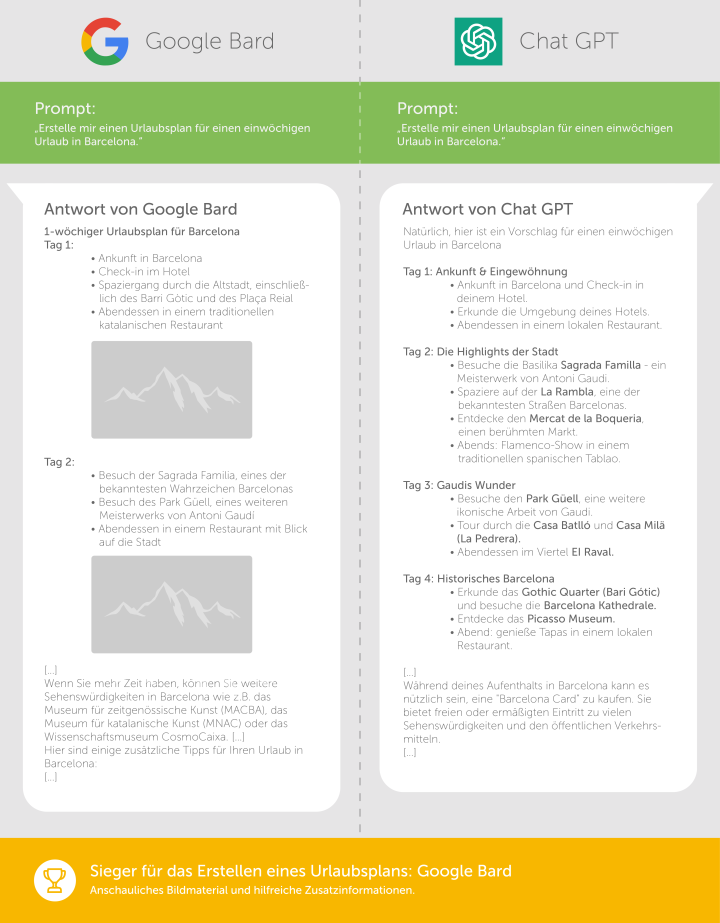
Summaries - Google Bard vs Chat GPT
Are you interested in a particular article, but don't have the time or inclination to read it in full? Google Bard and Chat GPT can help here too! But which program provides the better summary for lazy readers?
Both systems were asked to provide a summary of a DREIKON blog post. The input was: "Summarize the article for me: https://www.dreikon.de/aktuell/glossar/cross-selling/." This is where the first difference becomes apparent: while Google Bard delivers a summary of the article without any problems, the OpenAI chatbot Chat GPT displays the message that external websites cannot be accessed. The content of the article therefore had to be inserted manually.
Google Bard and Chat GPT ultimately provide good summaries of the article. However, Chat GPT's summary is more complete: Google Bard completely excludes the advantages and disadvantages of cross-selling, although these are discussed in detail in the text. In addition, the Google language model cites its own examples that are not even listed in the original article - this can lead to misunderstandings and is therefore very problematic. This freely invented, erroneous information from an AI is also known as "hallucinations".The summary of Chat GPT contains all the relevant findings from the text, without giving any examples of its own. This means that the AI response meets the requirements exactly.
Google Bard vs. Chat GPT: The OpenAI language model is better suited to writing summaries due to its high content quality and completeness - even if the article has to be inserted manually.
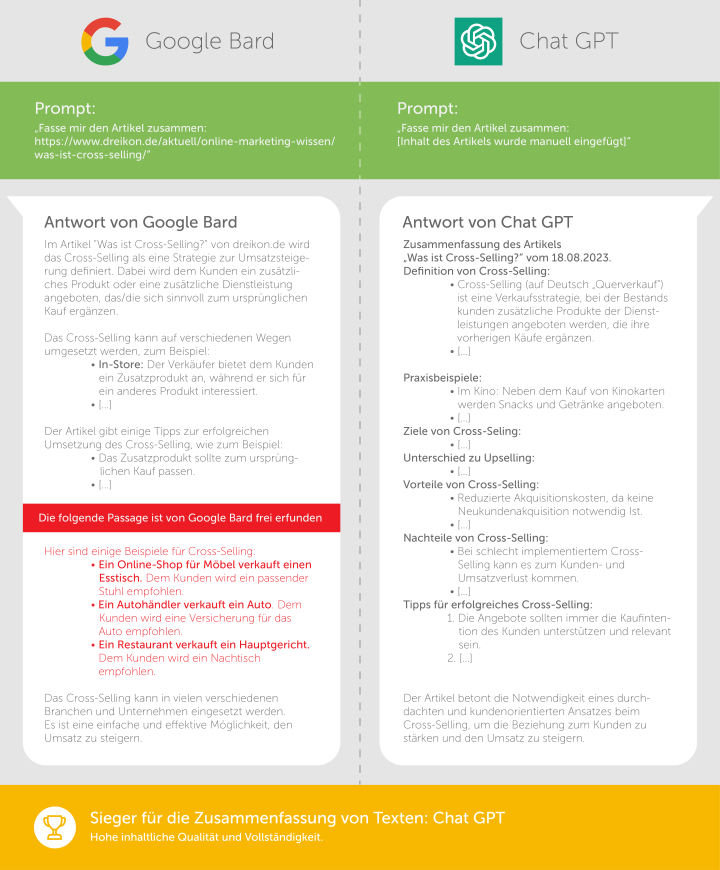
Fact check - Google Bard vs Chat GPT
Users are looking for quick and factually correct information online. Are Google Bard and Chat GPT also suitable for this?
The input was "What do you know about the Aasee in Münster?". Google Bard and Chat GPT then provide factually correct information about the Aasee. Both answers have a high information density and a structured overview of the most relevant core information about the lake. However, Google Bard scores with a large amount of number-based information that is not presented at all or in less detail in the OpenAI model's answer.
Google Bard is also ahead in terms of current information, as Chat GPT was only trained with data sources up to the end of 2021 from OpenAI. If you ask Chat GPT a question about current world events, OpenAI's language model only refers to external internet sources where the relevant information can probably be found.
Google Bard vs Chat GPT: Google Bard is clearly ahead when it comes to factual research


Google Bard, Chat GPT and DREIKON
Google Bard and Chat GPT offer impressive possibilities, but what happens when you combine these advanced technologies with unique human expertise? This is where the true value of our work lies: the combination of artificial intelligence and a deep understanding of human emotions, values and needs. AI can analyze data and recognize patterns, but it's the human eye that gives your brand life, personality and relevance.
Google Bard vs Chat GPT - an overview of the competencies of AI
Google Bard and Chat GPT - which language model is better?
There is no general answer to this question, it depends on the user's intentions and expectations. Google Bard is better at researching facts and up-to-date information - without spending any money. The Google chatbot is not limited to answers from the internet: The AI has recently been able to scan Google Mail, Docs and Drive to find the information you're looking for. This new integration allows users to find and summarize emails or highlight the most important points of a document stored in Drive.
So while Google Bard is more suitable for the sober procurement of information, Chat GPT scores highly in terms of creative text creation. Both AI programs have their strengths and weaknesses.

Hand in hand with artificial intelligence
Google Bard and Chat GPT are not competition for us, but helpful tools. Combined with strategic planning, thorough research and many years of expertise in SEO, artificial intelligence can add value to our services - and therefore to you too. Our texts impress with their individuality and innovation. We are also happy to achieve maximum visibility in search engines for you. We look forward to getting to know you in a non-binding initial consultation!
The connection between AI and search engines
Artificial intelligence is radically changing the way we obtain information. It was only a matter of time before search engines started cooperating with AI chatbots. Since April 2023, Bing search has been possible with the integrated OpenAI language model Chat GPT. Shortly afterwards, Google announced the "Search Generative Experience": Google searches will generate an AI answer above the usual search results list.
Search Generative Experience
The Search Generative Experience is an independent AI project from Google. Unlike Google Bard, it is not based on the LaMDA language model, but on MUM and PaLM2, among others. It is currently only available as a beta version in the USA. It is not yet clear when it will be available in other countries.
Similar to Chat GPT in Bing, a text appears when a search query is made, which answers the question based on various sources. In addition, a carousel with three boxes or links to the AI information appears as an incentive to carry out independent research using the source information.
Chat GPT and Bing
The integration of Chat GPT in Bing is intended to revolutionize the search for information. After a search query in the OpenAI chatbot, a specific answer is offered instead of a list of links. In future, images, videos, diagrams and graphics will also be added to the response text. A major advantage: in combination with Bing, the Open AI language model can also provide information about current world events.
Google Bard, Chat GPT and SEO
AI has a considerable influence on the search behavior of users. The user himself or the user's expectations and needs are thus becoming even more central.
This development is also underlined by the "Google Helpful Content Update", which was introduced in September 2023. Google is thus relaxing the guidelines for AI-generated content - it is no longer bad per se. The previous guidelines emphasized that the algorithm prefers content created by humans. The update puts the focus on high-quality and helpful content. Google is thus giving priority to content that offers real added value and fulfills the intentions and expectations of users in a targeted manner - regardless of whether this content was created by humans or machines.
Targeted, search engine-optimized and highly target group-oriented content is now more important than ever.
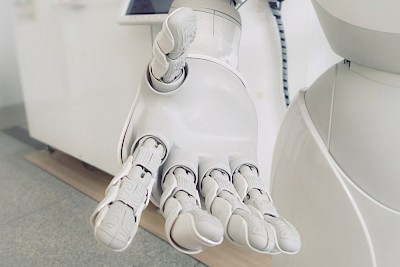
The limits of Google Bard and Chat GPT
Google Bard and Chat GPT are artificial intelligences that merely try to imitate human conversations. When it comes to more than simply obtaining banal information, human communication skills remain unbeatable. Sincere interest, compassion, empathy, emotion, ethics and morality - these qualities remain deeply human and ultimately determine the quality of a conversation between interlocutors.
After all, chatbots are only as good as the data they are fed with. The results of chatbots should always be viewed critically, especially with regard to the OpenAI language model, which is up to date as of the end of 2021. It is not for nothing that Google Bard offers the option of manually checking the statements made by clicking on the Google logo. It is essential to compare the AI-generated information with verified sources.
Google Bard vs Chat GPT: Legal consequences
Despite all the media enthusiasm that Google Bard and Chat GPT have generated, the technical innovation of chatbots has also raised legal issues and challenges. Agencies and website owners in particular are faced with new considerations in terms of data protection, copyright and liability. What legal pitfalls arise from the implementation and use of these advanced AI models?
The blind transfer of texts and text excerpts from chatbots can lead to legal hurdles in many respects. Here's what you should bear in mind when dealing with AI so that you don't get caught:
Data protection
In addition to the fact that chatbots are not permitted under data protection law in Europe simply because they are US-based, the question arises as to whether and how personal data is processed by Google Bard and Chat GPT. Are the chatbots authorized to process a user's confidential data for other users? This question is still unclear. Agencies and website owners should therefore exercise particular caution when transferring content that contains personal information. The content of chatbots should never be adopted blindly.
Personal rights
If the content of Google Bard and Chat GPT contains false, defamatory or copyright-infringing statements, the user is fully liable for these. An author who publishes third-party content makes it his own; in the event of a violation of personal rights, he is therefore fully liable. It is essential to check the truthfulness of chatbot content before reproducing it on your own website.
Competition law
Competition law problems arise when Google Bard and Chat GPT make explicit recommendations. So far, therefore, no recommendations have been made for restaurants, doctors or similar. However, it is very likely that both Google Bard and Chat GPT will monetize their search results in the future in a similar way to Google Ads.
Product liability law
Can a user sue ChatGPT and Google Bard if they provide them with incorrect instructions on how to plug in a socket and this results in significant damage? All legal questions in this area are still unresolved. In most cases, the basic user verification period applies. A legal regulation is currently being prepared at EU level ("Artificial Intelligence Act").
Right of use
It is worth taking a look at the terms and conditions of the respective service. Both ChatGPT and Google Bard allow the commercial use of their content. However, the results of Bing Chat GPT may not currently be used commercially. In order to avoid legal problems, the terms and conditions should be checked regularly.

Why texts from our agency are worthwhile
The expertise of our experienced SEO agency is more important than ever in the age of AI. We create unique, helpful and high-quality content to keep your website at the top of the search results. We look forward to getting to know you and your business!
The relevance of online marketing agencies in the age of Google Bard and Chat GPT
The "Google Helpful Content Update" does not make an experienced online marketing agency any less relevant - on the contrary. High-quality, search engine-optimized and target group-oriented content is more important than ever. Although human-generated content is no longer automatically preferred to AI-generated content, human-generated content still has a decisive advantage: uniqueness. AI-generated content is based on a limited amount of data. Although Google Bard and Chat GPT can quickly provide superficial information or creative texts, they do not have a wealth of human experience, emotions, empathy and an ethical and moral value system. The quality of content suffers significantly as a result.
Working as a full-service online marketing agency requires adaptability and passion. We are always informed about innovations from the world of search engine optimization, artificial intelligence and online marketing to ensure the long-term success of your online presence. Whether Google Bard and Chat GPT or Copilot and Jasper - AI chatbots are not competitors for us, but helpful tools that enrich our work, but cannot replace it.









